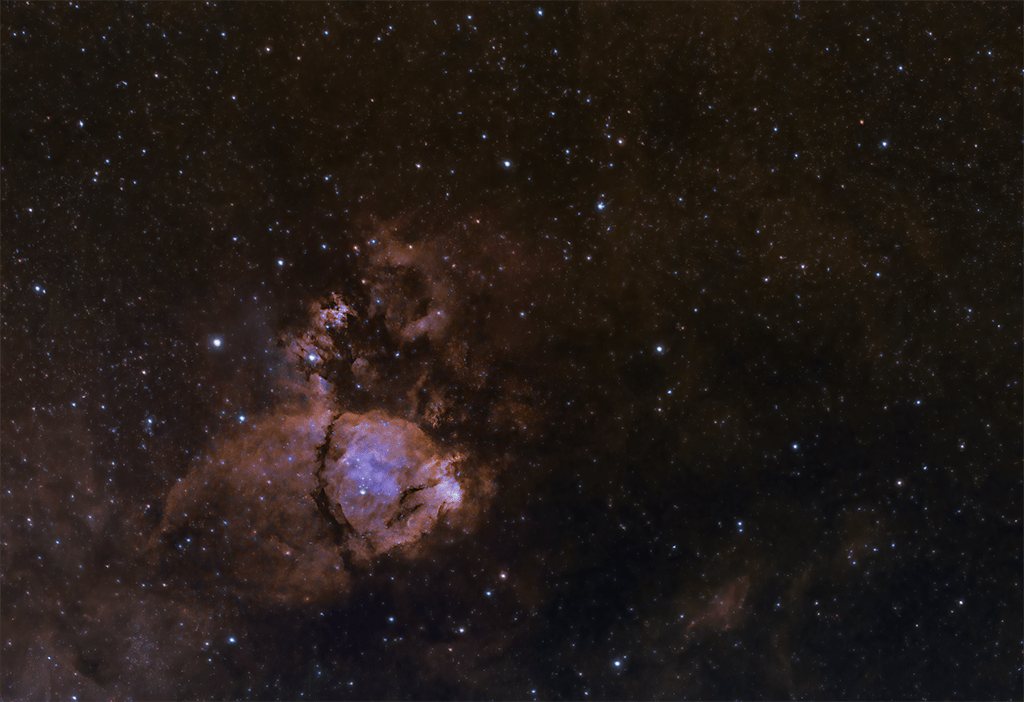IC 1795 is a nebula of glowing gas and obscuring dust in the constellation of Cassiopeia. It vaguely resembles the head of a fish; hence, its unofficial nickname—The Fish Head Nebula. It lies in the band of the Milky Way close to the Heart and Soul Nebulae, and the famous Double Cluster, and is part of a much larger star forming region.
The first image in the gallery above, which is predominantly red, is in ‘natural colour’. The second image with blue and yellows is in false colour. Using the Altair quad-band one-shot colour filter, the camera’s red pixels record Hα and SII (the alpha and II spectral lines of ionised Hydrogen and Sulphur respectively), the green pixels record OIII (the III spectral line of ionised oxygen), and the blue pixels record Hβ (the beta spectral line of ionised hydrogen). To create this false colour image, guided by the Hubble or SHO palette, I remixed the channels as:
- Red = 100% (Hα + SII) – 20% (Hβ)
- Green = 80% (Hα + SII) + 20% (Hβ)
- Blue = 100% (OIII)
The reason for involving Hβ in the remixing is that I considered it as indicating the presence of hydrogen and of Hα emission also. I therefore used it to very approximately separate Hα from the combined Hα + SII signal, with 20% a value reached arbitarily by adjusting to taste.
A couple of months have passed since my last astrophotography project on 21 July 2020 of Saturn and Jupiter. The weather at night has generally been really cloudy so there have been very few opportunities. I did, however, recently spend one precious clear night setting up my new Skywatcher EQ6-R Pro mount. I bought it second hand to replace my Skywatcher EQ5 mount in my deep-sky astrophotography rig (which is not matched very well for the payload), hoping to achieve more accurate guiding.

The mount did not disappoint! For subpixel guiding accuracy and pin-point stars, my guiding error must not exceed 1.22 arcseconds, and ideally the RMS error should be around half of that value. From the screenshot of PHD2 below, you can see I was guiding with an RMS error of 0.60 arcseconds, which is exactly what I need. I haven’t weighed the total payload, but I estimate it is no more than 7.5 kg. For the first time ever, I managed to collect 50× 5-min exposures without losing a single frame to guiding error, and my stars show no evidence of guiding error at all!

My EQ-5 is now about to be listed for sale on astrobuysell.com as I don’t need it anymore! It is a really good portable mount that performed admirably well. It would be ideal for a smaller telescope, but it’s not optimal for my setup.
Frames
- 50× 300-s light frames (Gain 900)
- Full use of calibration frames (darks, flats and dark flats)
Equipment
- Explore Scientific ED 102 mm Apo f/7 refractor
- Sky-Watcher EQ6-R PRO SynScan GOTO equatorial mount
- Altair Hypercam 294C PRO colour fan-cooled camera
- Revelation Adjustable Field Flattener
- Altair quad-band one-shot colour (OSC) 2″ filter
- Altair 60mm guide scope
- Altair GPCAM2 AR0130 mono guide camera
Software
- Sharpcap
- PHD2
- DeepSkyStacker
- Photoshop
- Topaz Labs DeNoise AI



